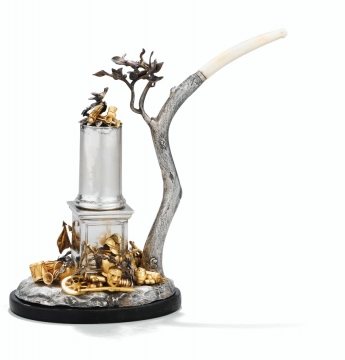The Léon Courtin-Marcelle Bouché Fund, managed by the King Baudouin Foundation, has purchased a remarkable commemorative pipe, a rare example of Belgian miniature silverware.
The pipe was made as a souvenir of the Battle of Waterloo (1815). It reproduces the Column of Peace erected in 1817 in honour of Lieutenant Colonel Sir Alexander Gordon. Gordon, who was the Duke of Wellington’s aide-de-camp, died from his wounds on the battle field, at the age of 29. This is a simplified version of the monument, which can still be seen in Waterloo, and it bears on the plinth the inscription Columna pacis 1815. The column is decorated with numerous objects – leaves, a quiver, a bird holding an olive branch, trumpets – mostly in vermeil, symbolizing peace. The objects around the plinth on the other hand – rifles, swords, banners, drums, cannon balls, helmets, a wheel and a cannon – refer to war. The pipe stem is in the shape of a tree trunk with a leafy branch and refers to the renaissance of a better world.
The pipe dates from the Dutch period (1815-1830) and is ingeniously crafted. The column can be unscrewed, so as to release the pipe bowl. The name of the person who commissioned the work, perhaps one of the battle’s veterans, as well as that of the silversmith, is currently unknown. Apart from the initials VJF – no doubt those of the owner – and the diamond-shaped master’s hallmark, one can also observe:
- a hand with a stick and a letter: the hallmark of guarantee (1815-1832)
- two laurel branches around the figure 2: the hallmark of title (1815-1832)
The pipe really could be used, although it was created as a small piece of sculpture. It is a rare example of Belgian miniature silverware and it is of remarkable quality. The reference to a monument, as much as to a major international event, tells us about the perception of the Battle of Waterloo at the time of the event. The work can also be considered as a link between the French period (1794-1815) and the Dutch period (1815-1830). Likewise, the diamond-shaped hallmark enables us to deduce that the work was made during the Dutch period by a silversmith who had already been working during the French period, thus confirming that it can be considered as a real link between the two periods.
It is because of its unique character and its historical importance that this commemorative pipe was purchased by the Léon Courtin-Marcelle Bouché Fund at Sotheby’s in Paris. The pipe has been entrusted to the Sterckshof Silver Museum of the Province of Antwerp, which is also responsible for conducting further research about the silversmith and the person who commissioned the work.
